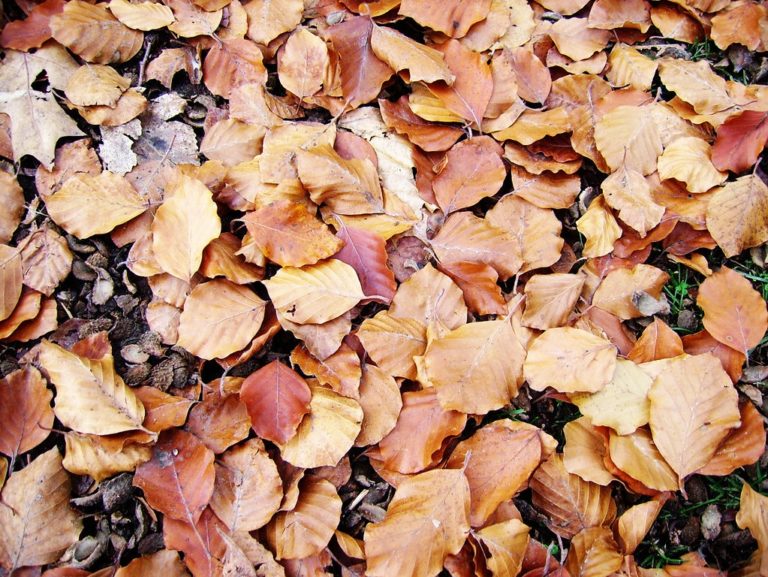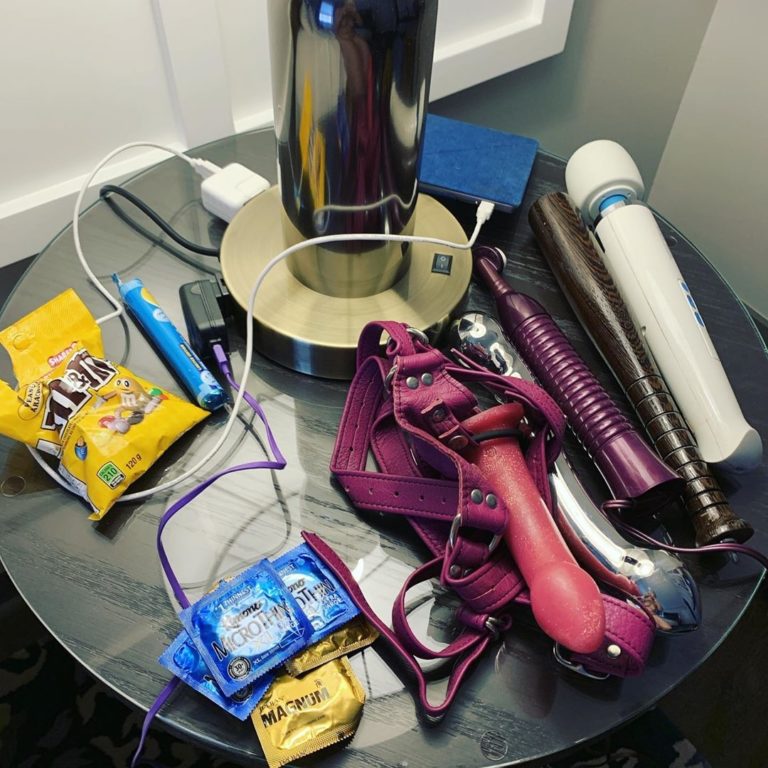
Yeah, I’ll say it: fall is the second-best season, after spring. (Don’t @ me.)
Now that it’s officially ~the cozy season~, I’m thinking about all my favorite ways to celebrate the dropping temperatures, shortening days, and yellowing leaves. Here are 25 fall-appropriate things to consider doing in the next few months…
Heat things up with temperature play. On the hottest summer days this year, my partner rubbed a giant ice cube all over my body as part of a surprisingly intense kink scene – but now that things are cooling down, we’ll likely get back into a perennial fave, wax play. All you need to get started is candles made specifically for wax play (they burn at a safer temperature than regular candles), a tarp or water-resistant sheet to keep wax off your bed, and a butter knife or credit card to scrape off the dried bits at the end of the scene. Doing wax play on a cold night, with the windows open and good music playing, is one of my favorite kinky sensory joys.
Invest in some new cozy clothes. You know that in a few months, you’re probably gonna be bored to death of your boots and coat and sweaters and jeans (at least, that’s how it goes for me), so might as well take advantage of the freshness of the season and give your wardrobe a boost. I am deeply enamored with Old Navy flannels, vintage cashmeres, and basic black leggings; these things basically get me through until the snow thaws!
Make your “to-read” list for the season. We’re getting into the best months for cuddling up in bed with a book, or bringing one with you on a solo date to a beer hall or Indian restaurant or wherever your heart desires, really. Once you know what you want to read, you can get to work sleuthing out those titles at local bookstores or libraries (or, if you’re like me, just unearth them from your own ever-growing collection). If you’re stuck for ideas, here are all the books I’ve read in 2019.
Go on a cozy coffee date. With a beau. With a friend. With your mom. By yourself. Whatever. The point is, go spend some quality time with somebody you love, over hot bevs, in a lively and bustling establishment. It’s a seasonal must-do.
Discover your new autumn soundtrack. There always comes a point in September or October when my favorite summer jams just don’t quite cut it anymore. I want to shift into music that feels autumnal, less optimistic and more wary than summery tunes, but still warm and familiar and lovely. Some faves of mine: Fleet Foxes, Pinegrove, Tobias Jesso Jr., Paul Cook & the Chronicles, Alvvays, Jeremy Larson, Violents, and Sufjan Stevens.
Try a dark lipstick. Even if you’re “not a lipstick person” and you have to borrow your femme friend’s bullet of Viva Glam III. I swear, putting on a black or purple or deep berry shade can transform your face and make you think about your self-presentation differently for a while.
Devour a new-to-you podcast. Maybe it’s because I miss going “back to school,” but there is something about fall that makes me want to dive headlong into intellectual pursuits and stuff my brain with new knowledge! My two newest faves are You’re Wrong About and Punch Up the Jam – both total aural comfort food, for vastly different reasons.
Cuddle a lot. I mean. Do I even have to explain this one? If you don’t currently have an intimate partner with whom to partake of snugglin’, there’s always friends, pets, and random well-meaning folks from Tinder.
Spend some time in a library. Libraries are some of my very favorite places on earth. They’re so quiet and calm and packed with emotional resonance. They also provide vital services and resources to many, many people, so supporting them is always a worthy use of your time. (I’m sad I no longer live within walking distance of the gorgeous Bloor/Gladstone library here in Toronto, though now I’m closer to the Lillian H. Smith branch, which is also very pretty.)
Devise your Halloween costume. It’s a little early, yes, but if you wait too long, you’ll be reduced to grabbing an ill-fitting sexy uniform off the rack at some godawful party store on October 30th! Give some thought to which celebrities, fictional characters, or concepts you might want to represent in your spooky ensemble this year.
Take cute selfies against a foliage backdrop. This season is very pretty and you may as well wring some Instagram content out of it.
Shop for new writing supplies. Academic vibes are in the air, and so, like I do every September, I’m aching for new notebooks, pencils, pens, and highlighters! I love Poppin‘s color-coordinated desk supply sets, Blackwing‘s elegant pencils, and the incredible pen selection at JetPens.
Learn to make a new meal. I cook at home more often in the colder months because, frankly, I can’t be arsed to leave my apartment as often. Check Epicurious and the Bon Appetit YouTube channel for ideas. Sweet potato risotto is one of my autumn faves; this year I’m also hoping to learn to cook more things that incorporate smoked tofu (yummm).
Wear leather and flannel. They are simply some of the most suitable materials for this weather. I always feel very bisexual when I wear them together.
Update your social media bios. You’ve probably grown and changed at least a little since the last time you did this, so it’s time for some tweaks. Hype your latest project, hone the titles you call yourself, and put your pronouns in there if you haven’t already. (While you’re at it, why not update your FetLife fetishes list, too?!)
Try a new hot beverage. Listen, I’m not going to tell you that you have to drink a pumpkin spice latte at least once this season, but… I’m not not going to tell you that, either. If you drink alcohol, I’d also highly recommend finding a place near you that serves some kind of hot toddy, mulled wine, or other warm boozy beverage – they make cold nights feel so much cozier!
Reach back out to people you’ve been missing. I find it’s trickier to stay social when temperatures drop, because – again – I don’t like leaving my house when it’s cold, and neither do a lot of people! So this is a great time to start being more intentional about your social connections. Set up some catch-up phone calls, throw together a fancy potluck, send your great-aunt a loving email, etc.
Do a digital deep-clean. Does your downloads folder really need to have that much stuff in it? Does your home screen need that many apps cluttering it up? Is everything in your bookmarks bar really necessary? Look at your digital landscape with critical eyes and axe the unimportant, to make way for the new.
Upgrade your home’s coziness quotient. Okay, nobody told me just how much it would change the entire vibe of my room to buy velvet cushions for my couch. It’s also important to have a blanket around (bonus points if it was knit by someone who loves you), some extra pillows for your bed (for all that reading and lounging you’re going to do), and maybe a small space heater or something else that’ll keep you comfortable this winter.
Watch scary movies. I am a wimp, so I only like to do this one of two ways: either cuddled up with someone who I would trust to keep me safe if a zombie broke in, or by myself and extremely stoned (that way, the blood and bones and guts are mostly just funny to me, not scary). Honestly, most of my favorite horror movies aren’t horror movies at all but episodes of American Horror Story, one of the most perfect shows ever created. (I think Asylum, Hotel, and Cult are the best seasons.)
Go on a long walk. Gotta get that fresh air into your lungs before it becomes so cold that it hurts to breathe! Stick some good music or podcasts in your ears, put on some sunscreen, and go explore.
Try out a new scent. The ladies of the Dry Down wrote a stunning piece 2 years ago about what they then deemed the best scents for fall, and the ones they picked are still some of my favorites, especially Noel au Balcon and Winter Nights. If you’re not a perfume person, you could try out a new incense for your home, a new bubble bath, or an essential oil blend. I love how all my fragrances intermingle on favorite scarves by the end of the winter.
Decide on some new projects. There’s still time left in the year for you to get some shit done! What do you hope to achieve before the sun sets on 2019? And how can you get started on that path right now? Make some plans, scribble some to-do lists, set some goals. An excitable heart will help you get through the chilly months.
Have a party. Maybe it’s a “farewell to summer” party; maybe it’s a “pumpkin spice” party; maybe it’s a listening party for the new Tegan and Sara album (hi, we should be friends). Gather your favorite people close and find something to celebrate. Any time is a good time for this, so why not do it now?
Watch a sunrise. Right around now, sunrises start happening later in the morning, so you can actually catch one without getting up at an inhumane hour. If you can find a roof to watch it from, with a hot drink and a cute person, so much the better.
What are your favorite things to do in fall?





